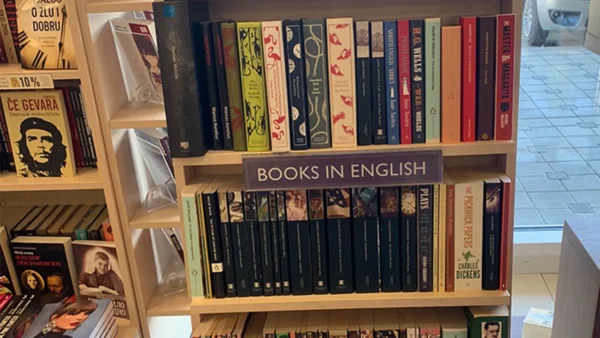There are some excellent stories in here, from big names like V.S. Naipaul, Patrick White, George Lamming, Chinua Achebe and Ngugi Wa Thiong’o (although this book is so old he is credited as James Ngugi, his birth name which he rejected as a sign of colonial influence). Also some good ones from writers I didn’t know, like R.K. Narayan from India and Amos Tutuola from Nigeria.
The editors, Anna Rutherford and Donald Hannah, have also provided for each of the 18 stories a couple of pages of introduction giving background about the author and a context for the story, often linking it to others in the collection and to the rest of the author’s work, which I really liked. I made notes on each of the stories – a lot of detail, I know, but pick and choose the ones you’re interested in. I just wanted to remember the stories, because I don’t own a copy of the book. I’ve split them over several posts, so this is part 1 – R.K. Narayan, Patrick White, George Lamming and Peter Cowan.
R.K. Narayan (India) – A Horse and Two Goats
This story draws a lot of humour from the conflict of incompatible cultures, as an American tourist tries to buy a statue of a horse from an old man in a small Indian village. There is complete misunderstanding throughout, as they have no common language. The old man thinks the tourist is a police officer because of his khaki clothes, and the tourist assumes the old man owns the statue when in fact he’s just watching his goats. The tourist’s conversation is all about money, ownership and practicalities, while the old man’s replies are about tradition and spirituality. There’s also a contrast of wealth – the old man’s lifelong dream is to sell his goats to raise 20 rupees with which to start a small shop selling nuts and sweets; the tourist easily pulls out 120 rupees from his wallet to buy the statue. The horse means different things to each of them – for the old man it will become an avatar to redeem the good people at the end of the world; to the tourist it’s a commodity to be bought. And to the young people in the village, they are “hardly aware of its existence.” Really enjoyed this one.
Patrick White (Australia) – Down at the Dump
According to the introduction, White wanted to explore the narrowness of Australian suburbia, but not to be completely critical – he wanted also to show the “extraordinary behind the ordinary, the mystery and the poetry which alone could make bearable the lives of such people”. The snooty Hogbens look down on their neighbours the Whalleys, who scour dumps for goods to use or sell. The central action is the funeral of Mrs Hogben’s sister Daise, who was shameful in the eyes of society but was actually practising Christ’s message of love, especially for the downtrodden – she took in a man she met at the showground who was down on his luck, and was ridiculed for spending time with a “scabby deadbeat” and “a Roman Catholic for extra value”. The Hogbens’ daughter Meg meets Lum Whalley at the dump, which is next to the cemetery, and they kiss. She wants to explore and discover life as her aunt Daise did, not be content with the narrow, judgmental world of her parents, which is mercilessly evoked through little details like having to clean her shoes every five minutes even though they immediately get dusty again, or to put plastic over the pixies in the garden to protect them from the rain – it’s all about surface appearances, whereas Daise and Meg are looking for something deeper and more true, even if socially unacceptable.
George Lamming (Barbados) – A Wedding in Spring
Again the comedy here is from a clash of cultures, although there’s also a serious undertone and a sadness to it, as the characters are Barbadians in England, displaced from their familiar culture and trying to mimic English customs. The lack of a cultural anchor or authority is clear – Beresford and his sister Flo argue over the marriage of Beresford to an Englishwoman, and constantly try to guess what their mother would do or want them to do. They seem adrift and far from the certainties of home. There’s some slapstick comedy, for example Beresford’s friend Knickerbocker ripping his trousers, but there’s also the sadness of living in an alien culture, trying to do the right thing but not knowing how or having the money. The friendships with the people from “back home” are strong, despite the arguments, but English people, even the bride, are virtually absent – although the wedding is central to the story, the bride is only mentioned once in passing.
Peter Cowan (Australia) – The Tractor
This is similar to White’s story in its criticism of Australian suburbia, but Cowan has no interest in finding mystery or poetry – suburbia in this story is a definitively negative thing, seeming to have a life of its own, swallowing up the land for no reason other than to give developers a tax break. It’s a relentless invasion – a hermit puts up a fight, and a developer’s wife helps him, but it feels hopeless. The wife, Ann, tries to argue against her husband, but he just says “You can’t stop progress.” She calls it “The unanswerable answer” and says “So we must all conform”. I liked the feeling evoked in this story, and how the land and suburbia seemed like characters of their own, beyond the human characters who were all pretty powerless in the end.
That’s it for now – more to follow tomorrow, with notes on Mordecai Richler, Lee Kok Liang, Wilson Harris, Frank Sargeson and Amos Tutuola.




There are 5 comments
I wanted to read short stories, didn’t know I would stumble on these big books. Percepts won’t do for me so I guess I’ll have to buy the books. My stories are still drafts so I have a lot to learn.
And I love the commonwealth, for giving writers a chance; to be heard and to be. Its our world, let’s write around it!
Thanks for the comments! I hope you like the stories. The book is quite old and might be hard to find, but it’s worth it if you can!